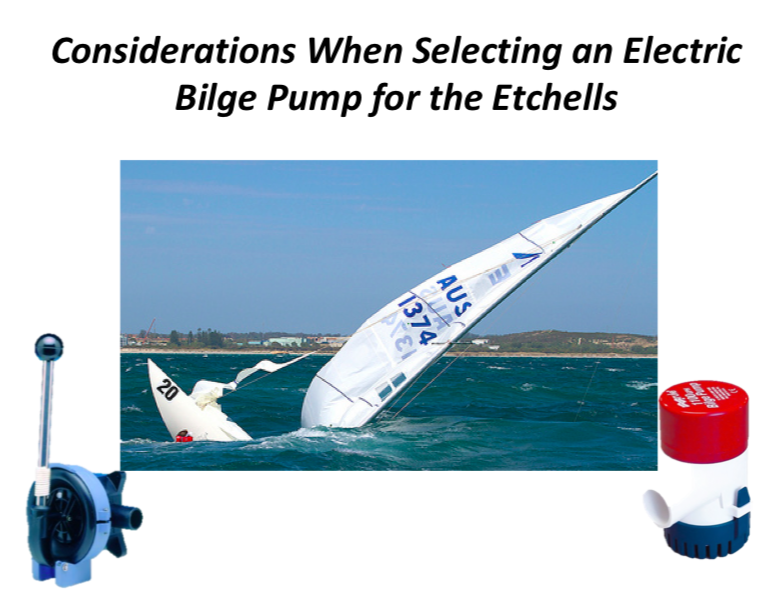This link opens an incomplete write-up of some options I considered when installing an electric bilge pump on my Etchells. In summary, I opted for a positive displacement pump, powered by a rechargeable lithium-ion battery with a solar charger and regulator. You may want a simpler system. Since I am using a lithium battery, I opted to employ protected (fused) circuits for safety. Since I now had all this circuitry, I also opted to integrate a fixed-base VHF radio integrated into the circuitry, since the sound from the base VHF radio is so much better than from a hand held VHF. YMMV.
Options for an Electric Bilge Pump, etc.
Just the Basics…

If you want to use a small Rule 24 (or similar) centrifugal pump, and you decide to use a bilge water-level switch, you can package it with a Waterwitch bilge switch and discharge hose something like this picture taken from the Waterwitch bilge switch web site. Run the discharge tubing out of the bilge and to the thru-deck fitting, probably up forward.
The electrical wires can be zip-tied to the discharge hose, as well. However, you will probably need to play around with the vertical location of the Waterwitch switch to get the pump to turn on and off at a suitable time. (Some centrifugal bilge pumps have check valves, but if the pump does not have a check valve, then when the pump turns off, the water remaining in the discharge hose drains back into the sump. The bilge sump is small, so the water level fills back up quickly with only a small amount of water. So, if the switch is too low, the pump just cycles back on and just refills the discharge hose until it turns back off. Never ending cycle until the battery discharges. So, the switch may need to be located a few inches above the pump. You will need to play around with the locations to get it right.)
If there is a checkvalve, the water stays in the discharge hose, which is also undesirable. That is a motivation for a positive displacement pump mounted near to the through-deck discharge port.
It might be preferable if the discharge hose is routed vertically up along the side of the pump instead of out the side, so **maybe** try adding an elbow on the pump discharge, if that seems like a preferred arrangement. Or, maybe a better approach would be to zip-tie each item to a “pole-like fitting” that you can then insert into the bilge sump. I am thinking the pole is an aluminum plate that is about the width of a paint stirrer or old-fashioned wooden ruler. You could use industrial velcro to attach the pole to the keelson, or screw it to the keelson, in a position such that the pump is located at the bottom of the sump. Maybe the aluminum is bent 90 degrees to wrap around the top of the keelson and you can screw it into the top surface of the keelson. The “pole” would allow you to position the water level switch at the “goldilocks” location.
Ideally, to pump the most bilge water out (by preventing the pump inlet sucking air), you want the pump vertical with the blue plastic inlet screen on the bottom of the pump positioned to sit flat down on the bottom of the sump area. But if the pump ends up sitting at an angle or even on its side, it probably leaves only a little more water in the sump. Moreover, the amount of bilge water remaining after the pump cycles off will be controlled as much or more by the final location of the switch itself.
However, for simplicity, you may decide to forgo the bilge level switch altogether and just put a rocker switch in the cockpit that the crew manually cycles to operate the pump when needed.
More Bilge Pump Ramblings
Here are pictures of the Whale Supersub pump on Tom Carruther’s boat – pix on Andrew “Dog” Palfrey’s website (give it a couple seconds to load and select the single picture)… URL: https://www.sailing.dog/project-management?pgid=jqprwg81-f726124d-7c55-448c-a070-3bd878786f1f
Hard to argue with anything that Andrew Palfrey does on an Etchells.
I see Rule has discontinued both the 360 and 500 pumps. Maybe there is still inventory out there such that you still can buy one.
Rule now offers an LP900S (or D) model that looks interesting. Only draws 4 amps. Looks like the similar Whale pump described above.
The Gulper 220 pump that I used does let some water back into the sump (not sure why, this seems to be a fault), so I had to play around getting the Waterwitch sensor at the right location. The Gulper is a positive displacement pump that should be able to suck all the water out of the sump and also from the inlet hose (right up to the pump). But, I have never looked into why it is not working the way **the theory** says it should. Maybe the valves in the pump don’t seal 100% or there is some gunk in them. At some point the pump starts sucking air, and that interferes with the whole pumping action; but it should have (mostly) emptied the long run of inlet hose. The only residual water should be in the discharge tube, which is only a few inches long. Theory vs. practice.
The concept of using a check valve to prevent water backflow is sound. If the check valve works and is not fouled with bilge gunk, it should help with the sensor position issue I wrote about earlier. A check valve can fail or get fouled up, so it adds some unreliability to the system. Moreover, you might want to consider where you want the residual water – in the hose, or in the bilge sump. From a center of gravity perspective, maybe it is better to have the water drain back into the sump. If you want a dry sump, then in the hose is better. The residual water will be in one place or the other because, by class rule, the pump discharge needs to be in the deck, and once the pump no longer has water at its inlet, it won’t pump anymore. But, I suspect it is maybe 4 or 5 lbs of water.
Odds and Ends
The Whale Gulper 220 that I use is 3.4 lbs. Heavy!
The Rule 360 is 9 ounces!
The newer pumps look like they have a water sensor built-in.
At one time, I came to the conclusion that the pump needed to be a small capacity, and those 1100 GPH pumps were too much. I think a pump that draws about 5 amps is about right. Lots of small batteries suitable for that electrical load.
I still like the Gulper 220 that I use, but it is heavy and needs a separate sensor. The Rule LP900S and the Whale SS5212 look good if they fit. I don’t know offhand how much space there is between the keelson and the hull.
I think the 2 bilge sumps are the same depth, but the aft one is a slightly larger dimension fore and aft. The problem is the limber hole between the 2 sumps is a little above the bottom of the sumps, and the small diameter hole restricts the flow from one sump to the other. Should be a larger hole and flush with the bottom of the sump.


Register for website access and Log in to add your electric bilge pump design ideas…